The 10 creepiest places in Europe
Here at One Weird Globe, I’m not a fan of fake scary stuff. Not when there’s so much real scary stuff to make you need new pants.
During our epic trip to Europe earlier this year, we made it a point to find the unusual, the bizarre, and maybe even a little macabre. It’s Halloween season now, which means it’s time to share some of my favorites with you.
Museum of Movies and Miniatures – Lyon, France
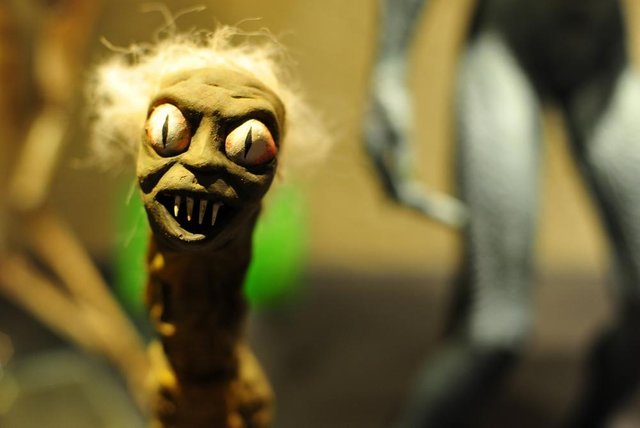
Creepy factor:


Kicking things off here is one of the first places we found in Europe that had a number of sections curtained off. A multi-lingual note outside the curtain warned that inside were some scary things for kids, and that parental discretion was advised. Look for plenty of movie magic, masks, characters, and so on – and don’t be fooled by the museum name. While there are indeed exquisite miniatures on display, they’re quickly skimmed by most where the movie magic is enjoyed by many. Play the trivia game What Movie Did That Character Come From? as you walk through.
Miniature Museum (Musée Miniature et Cinéma)
60 rue Saint Jean, 69005, Lyon, France
museeminiatureetcinema.fr
10am-6:30pm (Mon-Fri), 10am-7pm (Sat-Sun), ticket window closes 1 hour before close)
9 €, 6.50 € for children
Kostnice Sedlec Ossuary – Kutna Hora, Czech Republic
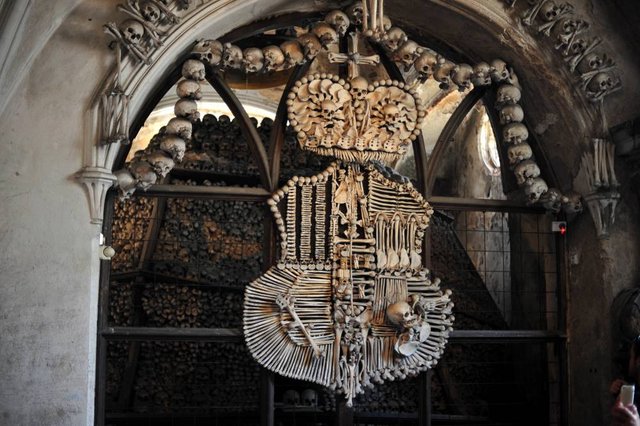
Creepy factor:




An absolute must if you’re taking a daytrip from Prague. The memorial site is home to the bones of 40,000 people, and while not set up to be scary, you are literally surrounded by dead people. Part of a Cistercian monastery founded in the 12th century, some 30,000 bodies were buried during 14th century epidemics, along with another 10,000 slaughtered during 15th century wars. The bones had been arranged by the time a chronicler arrived in 1630, supposedly done by a half-blind monk who got his eyesight back after finishing. The cups, garlands, chandeliers, and candleholders you see today date from the early 18th century to 1870. It’s easy to reach and well on the tourist trail, so there’s plenty of English around.
Kostnice Sedlec Ossuary (also known as the Sedlec Ossuary)
Zameck 127, 28408 Kutna Hora, Czech Republic
sedlec.info
90 CZK
Capuchin Church crypt – Brno, Czech Republic
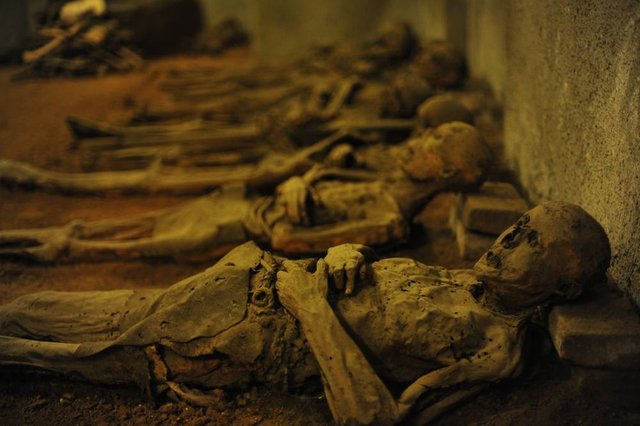
Creepy factor:




Naturally decaying bodies, anyone? Completed in 1651, the Capuchin Crypt in Brno is the final resting place of friars, nobility, church benefactors, and monks. It’s unique in that the bodies were left to decay naturally – with no embalming or burial preparation. (By the way, those adorable little monkeys of the same name? Named after these monks back in the 15th century when explorers found them in the Americas.) Some of the bodies are still in their coffins, either zinc or wood, and some of the inscriptions are quite readable. The English booklet has translations in case your Latin isn’t quite up to snuff. Look for Jan Vilem Count Zinsendorf (died 1695) as the oldest body in the crypt, while the Capuchin monks are buried as you see above, side by side and sans coffins.
Capuchin Church crypt
Kapucinske nam. 5, Brno 602 00, Czech Republic
April-Oct: 9am-6pm (Mon-Sat), 11am-5pm (Sun); Nov-Mar: 10am-4pm (Mon-Sat), 11am-4:30pm (Sun)
70 CZK plus 30 CZK ‘photo permission’
Ossuary of St. James Church – Brno, Czech Republic
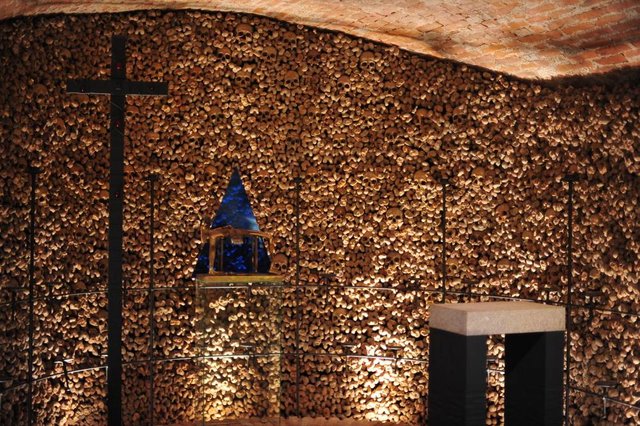
Creepy factor:



As ossuaries go, the dank, dark tunnels with bones around them often add to the creepy side of things. This one gets knocked down a notch on the creepy factor, but is possibly the most accessible and best-lit ossuary on the continent. Believe me, it makes a huge difference when you’re trying to do proper photography by the rules (e.g. no flash, no tripod). Originally from the 13th century along with the Church of St. James above it, bones would be moved to the ossuary from the cemetery some 10-12 years after burial. This made room for another burial to take place above-ground, and the circle of death continued on. The bones of some 50,000 people are thought to be here, making it the second-largest collection of its kind in the world.
Around the middle of the 18th century, the bones began to be organized and stacked to make space. Even with expansions, however, plague and cholera killed more than the space could handle, and in 1784 the cemetery above-ground was closed. Remains were brought to the ossuary, and the entrance from the church was sealed by stone. It wasn’t until 2001 that they were re-discovered as part of the church’s repair efforts. Since then, the area has been mostly restored with fresh lights and specially-composed music for the ossuary.
Ossuary of St. James Church (Kostnice U Svateho Jakuba)
Jakubské náměstí, Brno, Czech Republic
ticbrno.cz or brno.cz
9:30am-6pm (Tue-Sun), closed Monday
140 CZK
Klement Gottwald’s masoleum – Prague
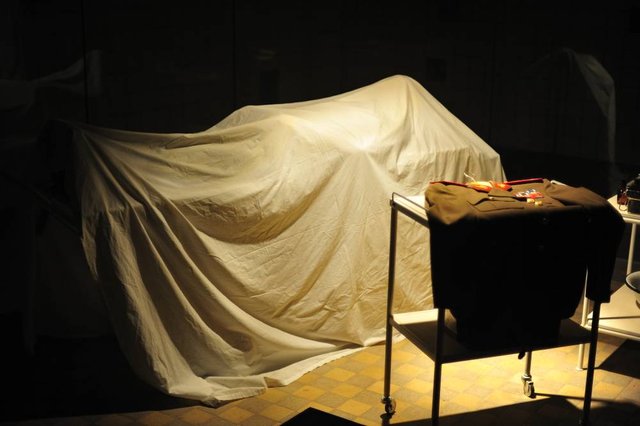
Creepy factor:



Part of a larger complex showing centuries of Prague and Czech history, this single part made the visit to the complex worth it, personally. Born in 1896, Klement Gottwald fought during World War I, was a part of the Communist party, and eventually became a “President of the Republic” in a coup d’état in 1948. In other words, a Stalinist dictator. He died in 1953, with his body laying in an open coffin as Lenin was. The body was embalmed annually, and this underground lab was constructed to preserve the body with the help of Soviet experts. The mausoleum opened that same year, and his preserved body saw an estimated 200,000 visitors a year. Despite the efforts of a team of 100 doctors and technicians, however, the body began to decompose. As the legs decomposed, artificial ones were put in place, followed by artificial arms and chest. By 1962, the body had decomposed to the point where cremation was the only option.
What’s here today is a reconstruction of that underground lab, along with the many gadgets and an elevator to lift the body up to the viewing level. It’s still an underground lab, mind you, and with the tools of embalming and a creepy story, it’s one best left to the adults.
Klement Gottwald’s masoleum (part of Vitkov Hill)
U Pamatniku, 130 00 Prague 3
Open 10am-6pm Wednesday to Sunday (closed Monday and Tuesday)
120 CZK (free with Prague card)
Imperial Crypt Kaisergruft – Vienna, Austria
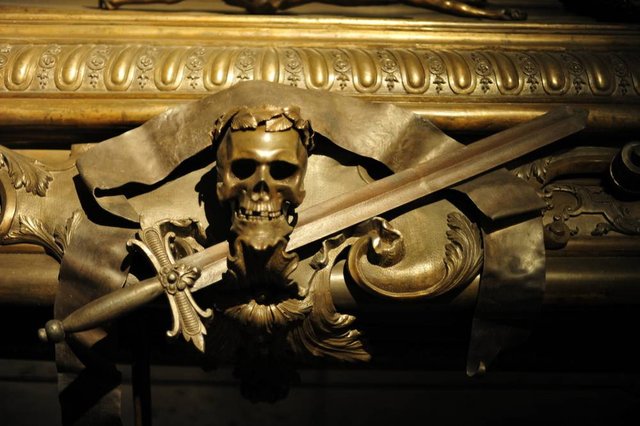
Creepy factor:



Home to former royalty and the House of Habsburg, the emphasis here is on the coffins and sarcophagi, not the dead bodies. Still, enough metal skeletons, swords, and intricate displays are here to tell the stories accumulated over centuries of conquering and warfare. In some cases, a person’s heart or intestines are buried in different places, though you’ll likely learn more about that from the Wikipedia page than on-site. The site was founded in 1618, but an Archduke was buried here as recently as 2011.
Photos are allowed and the lighting is generally good (great news for photographers), though signage is almost entirely in German. Bring along a German reader or a print-out of the Wikipedia page (it’s seriously one of the most fully-described places I’ve ever seen on the site).
Imperial Crypt Kaisergruft
Tegetthoffstraße 2, 1010, Vienna, Austria
kaisergruft.at
5.50 € (4.50 € with Vienna card)
Museum of Funeral History – Vienna, Austria
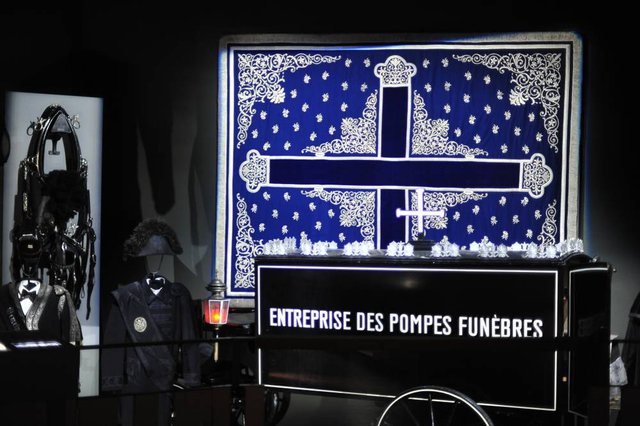
Creepy factor:



Renovated and re-opened in October 2014, the Museum of Funeral History is about as clean and modern as you’d expect a European museum to be. You’ll need to walk through some of the cemetery to reach it, but it’s a very accessible place with centuries worth of symbols surrounding funerals. Though it has a clear focus on the pomp and circumstance of a funeral, you’ll also discover the death masks and death notices here. Look for some names you might recognize among them: Strauss, Brahms, and Haydn. Before leaving, peruse the souvenir shop for some quirky souvenirs (noodles in the shape of a skull and mini-coffins were my favorites). As you might expect it’s very dark on the inside, and a number of black exhibits are lit just enough for the human eye to make them out. Photography’s a bit difficult even with pro equipment, so employ the hand rails to steady your shot.
Museum of Funeral History (Bestattungsmuseum am Wiener Zentralfriedhof)
Zentralfriedhof Tor 2, Unter der Aufbahrungshalle 2, Simmeringer Hauptstrasse 234, 1110, Vienna, Austria
bestattungsmuseum.at
9am-4:30pm (Mon-Fri), closed Sat and Sun
4 € (audioguide: 6 €)
Berhaus / Charnel house / ossuary – Hallstatt, Austria

Creepy factor:




Now we’re getting somewhere. Requiring both a train ride and a ferry ride to reach, this part of Austria is worthy of a couple days as you’re passing through (the salt mine is another highlight). The ossuary comes by a few names, but is most commonly known as Karner (Charnel House) or simply Beinhaus (Bone House). It’s up the hill near a large Catholic church and next to the 12th century St. Michael’s Chapel. As with other ossuaries, space for burying people was at a premium – doubly so for a church that’s essentially on top of a rock. After being buried for a decade or so, the bodies would be exhumed to make room for more people – but the twist here is the paintings. In 1720, the skulls (and only the skulls) would be bleached in the sun, then painted with their names and birth / death dates to commemorate their lives. Styles varied somewhat, and not every skull was painted (possibly due to the difficulty in identifying people decades after they’ve passed).
While it’s a small room no bigger than an average bedroom, the 1,200 or so skulls on display paint a powerful tale of a small community remembering its own. The careful paint jobs may seem macabre, but they’re part of the area’s unique charm.
Beinrhaus / Charnel house / ossuary
Chapel of St. Michael, Hallstatt, 4830, Austria
10am-6pm
1.50 €
Luigi Cattaneo Anatomical Wax Model Museum – Bologna, Italy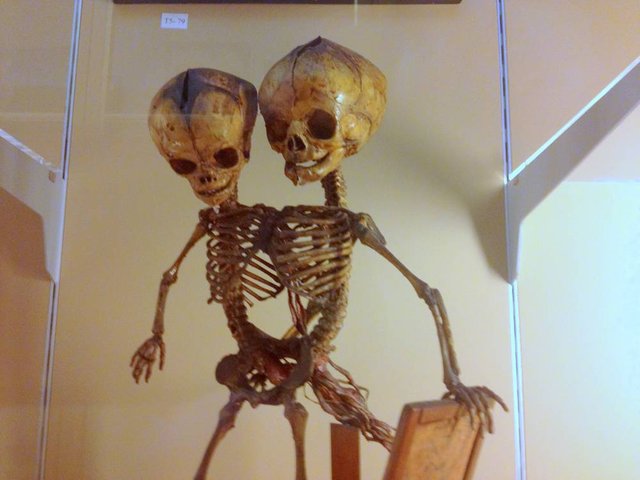
Creepy factor:





If this isn’t the stuff of nightmares… Like many anatomy museums, the original aim was not to creep people out, but to educate. Back in the early 19th century, would-be doctors examined extremely detailed wax models to learn about human anatomy, which were carefully created after consultations with the patients or descriptions. The collection is named after the collector, though credit should also go to the Florentine creator Clemente Susini, and the Bolognese wax modellers Giuseppe Astorri and Cesare Bettini. The collection focuses on the bizarre conditions found in humans, including congenital malformations, pygopagus (two babies with four arms, four legs, and joined at the stomach), tumors of kidneys, and plenty more. If you have any background in medicine, you’ll appreciate the exacting detail used long before photography could ever fix a form.
Oh, and don’t forget the 1,400 skulls of criminals that line the halls on your way in. It’s not quite a gauntlet, but it’s close.
Anatomical Museum of Luigi Cattaneo (Museo delle Cere Anatomiche)
2nd floor of the Istituto di Anatomia Umana Normale, Via Irnerio 48, 40126, Bologna, Italy
www.museocereanatomiche.it
10am-1pm and 2pm – 5:30pm (Monday-Thursday); 10am-2pm Friday. Closed weekends and holidays.
free
Check out some other fun things to do in Bologna,courtesy of Jet Settera.
Fontanelle cemetery (Cimitero delle Fontanelle) – Naples, Italy
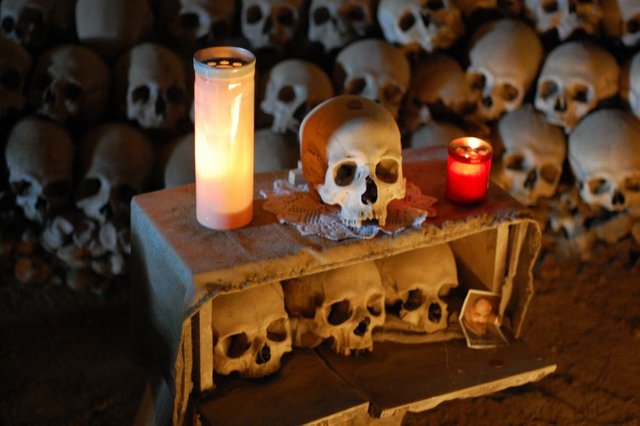
Creepy factor:




While far from the easiest place in Naples to reach, the skulls – and the story – make it worth the effort to reach. Instead of entering a church or a crypt, you’ll enter what amounts to a very-high-ceilinged 30,000 square-meter cavern. For reference, your average Wal-Mart is about 9,500 square meters. Put three of those underground and fill them with millions of bones.
First put into use in the 16th century, it became the ‘pauper’s grave’ for plague victims too poor for a funeral. During the 17th century, a flood washed the bones from the cave onto the street, forcing the return of the remains to the cave. Fast-forward to 1872, when Father Gaetano Barbati set out to clean and catalog the collection. A ‘cult of devotion’ formed, where people cleaned, prayed for, and ‘adopted’ the skulls of these poor purgatory-ridden souls. It was deemed a ‘fetish’ in 1969, and the site was closed to the public. Restoration began in 2002, and was opened to the public year-round in 2010. There’s very little information on-site, though guided tours are available with some tour companies. I can’t vouch for the guides at the entrance themselves, but you can easily walk past them to go at your own pace.
Fontanelle cemetery (Cimitero delle Fontanelle)
Via Fontanelle, 80, 80136 Naples, Italy
10am-5pm (guided tours at 10:30am, 11:50am, 1:50pm, and 3:10pm)
cimiterofontanelle.com
free
Congratulations @oneweirdglobe! You have completed some achievement on Steemit and have been rewarded with new badge(s) :
Click on any badge to view your own Board of Honor on SteemitBoard.
For more information about SteemitBoard, click here
If you no longer want to receive notifications, reply to this comment with the word
STOP